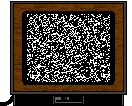
UNSCHEDULED TV
by Rachel Baker for VBI - the ambient.lounge during the 35th Int. Rotterdam Film Festival

unscheduled TV consumption and the elision of production and consumption
Convergence of Internet, TV and cinema brings new conventions and formats, new modes of behaviour and habits, new possibilities and new restrictions. The differences between these discrete mediums are worth re-emphasizing in terms of cultural phenomena rather than technology. Attention should also be brought to the formation of routines and rituals around production, distribution and consumption of the moving image in the age of desktop video editing, BitTorrent, and broadband.
Television is often derided as the degenerating, manipulative, pacifying instrument of corporate and state hegemony, but cultural studies students will also characterize it in more innoucuous terms: TV holds a central position within the various realities and discourses which construct everyday life, and is a predominant organising principle for households, families and communities all over the world. Moreover, the idea that TV is simply a propaganda machine only persists until the realisation that the medium is there to be manipulated, rather than to be manipulated by.
Understanding the future of TV in an age of digital convergence means understanding the impact on patterns of behaviour where the communal mode of watching scheduled TV has broken down, and where long-established professional modes of production are increasingly challenged by the autonomous amateur.
We didn't have a TV in our house until I was 13, an absence that induced a chronic addiction lasting for most of my teens. For good or for ill, many of my cultural references, sensations and perspectives have come from early 1980s British kids’ programmes and the rise of alternative TV. Cult TV emerged when the conventional TV formats were confronted with experimental, groundbreaking shows – often comedies such as Monty Python. One of the most recent cult TV shows to be smuggled onto mainstream TV in the UK, South Park, was available on the Internet before it was broadcast, and this is likely to be a more common model of distribution for innovative works of moving image.
The way viewing is structured by the TV apparatus, in particular by scheduling, is a key factor influencing consumption: TV shapes habits not only directly through programme (and ad) content, but also by creating routines of behaviour. When and in what circumstances a programme (or ad) is seen carries great significance for industry, particularly advertising. Before multichannel cable and satellite, TV culture in Britain was dominated by a scheduling regime emerging from an environment of only four channels. The BBC would go head-to-head for prime-time viewing spots with ITV and Channel 4. 7pm soap wars, or 9pm news, Friday night comedy, Saturday evening light entertainment – a whole range of viewing fare served up to structure the rhythm of ones day according to age, demographic, household composition, etc. TV advertising depends on this precise ordering of audiences and the (predominantly ad-free) BBC
is no less part of the game.
Multiple channels, BitTorrent, and broadband are changing our habits dramatically. Live Reality TV and football (also a mix of reality and drama) are probably the last bastions of large-scale communal TV watching, but while office conversations are all about last night’s episode of Big Brother or Pop Idol, at home computers are busy downloading entire series of Lost or CSI to view over the course of a weekend. The advertising industry is rapidly reinventing itself to adapt to new consumption habits.
Not only are consumption habits changing, but also the division between production, consumption and distribution is breaking down. The phenomenon of producing one’s own moving image content and webcasting online is still less widespread than the downloading of industry-produced content. Copyright control over the image is exerted rigorously, and video streaming is far less prevalent than audio streaming, but the opportunities afforded by cheap home video production and open online distribution channels are not to be ignored. The desire for shared narratives persists as ever – it is the possibilities to instruct or participate in the production and distribution of these narratives that have increased so dramatically.
In a gesture towards Gerry Schum’s Television Gallery of the early 1970s, I am attempting to assemble a diversity of projects that reconfigure approaches to TV (in the widest sense of the term) and consider the behaviours and habits we have grown up with and the new ones currently forming. This web directory of projects is entitled “Unscheduled Television”.
The projects presented in this collection represent a range of responses to TV culture and online moving image from artists and activists experimenting with the available technology – whether it be remixing existing TV, film and video footage, scratch video, online video art, videoblogs, online archives, or emulating and referencing TV culture nostalgically. The classification scheme is an initial sketch. As new projects are added, during and after Satellite of Love, a more robust scheme will emerge, based on the nature of the activities (rather than the medium).
-> Unscheduled TV project page
